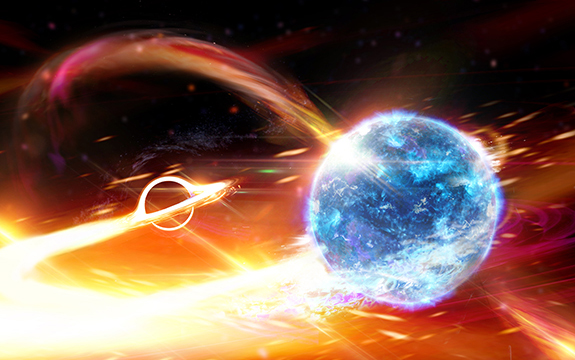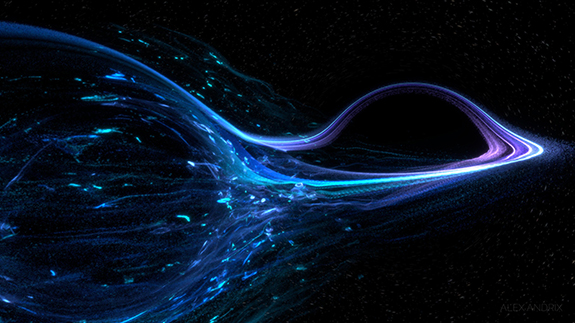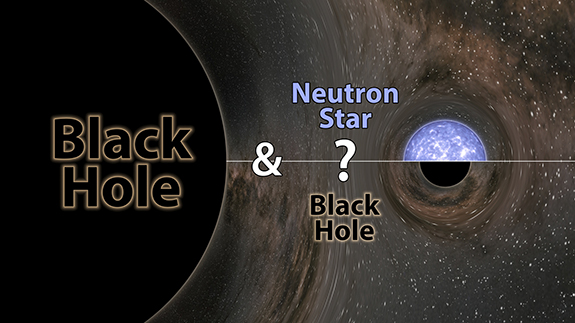Scientists find mysterious astrophysical object in black hole collision

In Summary
- Gravitational waves caused by the collision of a black hole, weighing up to 25 times the mass of the Sun, accompanied by a mysterious astrophysical object—around 2.5 times the mass of the Sun have been detected
- Researchers predict the object is likely to be either a dense star, or another black hole
The LIGO and Virgo observatories have announced the detection of gravitational waves caused by the collision of a black hole, weighing up to 25 times the mass of the Sun, accompanied by a mysterious astrophysical object—around 2.5 times the mass of the Sun.
Researchers predict the object is likely to be either a dense star, or another black hole; however, its mass contradicts this theory: it’s heavier than expected for a neutron star and lighter than a black hole.
Understanding what caused the gravitational waves in this cosmic event (called GW190814) is a classic ‘big data’ challenge for scientists. But this discovery is much more unusual and exciting than scientists had ever expected.

Artist’s impression of black hole collision. Credit: Alex Andrix
Black holes and neutron stars are two of the most extreme objects ever observed in the Universe—they are born from exploding massive stars at the end of their lives. Typical neutron stars have a mass of one and a half times the mass of the Sun, but all of that mass is contained in an extremely dense star, about the size of a city. Imagine scooping up a whole mountain from the Earth—it would equate to a mere teaspoon of the total mass of a neutron star.
Black holes are even more extreme objects than neutron stars: they have a lot of mass, normally at least three times the mass of our Sun, in a tiny amount of space. Their gravitational pull is so strong that not even light can escape if it passes too close to a black hole. Calculations reveal the black hole collision happened between 700 million and one billion years ago, but it has taken that long for the gravitational waves to travel to the Earth.

Artwork by Robert Hurt, Caltech
The fact that a black hole weighing 25 times the mass of the Sun could collide with either a super-heavy neutron star or an ultra-light black hole has challenged the accepted understanding of star life-cycles and galaxies.
OzGrav PhD student Debatri Chattopadhyay at Swinburne uses simulations to understand how binary systems form, evolve and eventually merge over the course of their lives.
“A couple of things make this event unique: mergers of black holes or neutron stars seem to prefer mass companions that are similar in mass, like birds of a feather,” says Ms Chattopadhyay.
“This event has a black hole that is ten times more massive than its partner. The less-massive partner also has a mass range about 2.5-2.8 times the mass of the sun which falls in the ‘mass-gap’ region—the apparent interval between neutron stars and black holes.”
The GW190814 event poses some interesting questions as to how the strange object formed. The evolution of a binary system—two orbiting stars that are gravitationally bound to each other—describes the history of its formation and life. Gravitational-wave observations of pair mergers provide a window into the past lives of the binary companions.
Binary systems may live in isolation—far away from neighbouring stars. Or they may live within dense communities of stars which influence and interact with each other over their lives. However, as Ms Chattopadhyay explains: “The difference in masses between the companions makes it less probable that the system formed in isolation.”
So, it seems likely that GW190814 formed in a different way. One theory is that it was formed inside a star cluster, where there is a higher density of stars living together in the same neighbourhood. It's possible that each object was the result of a chain of collisions between many stars and black holes.
“In these dense environments, like star clusters, stars interact with each other more often. They form and break star pairs throughout their lives. This can create mergers between objects with very different masses,” says Ms Chattopadhyay.
Alternatively, one of the companions of GW190814 could have been in several collisions with other objects in the star cluster, before this observation. The possibility of an electromagnetic signal accompanying this gravitational wave event was also considered.
Scientists hope to soon unravel the mystery with more gravitational-wave observations in the future.
LINK TO PAPER: https://dcc.ligo.org/P190814/public/

